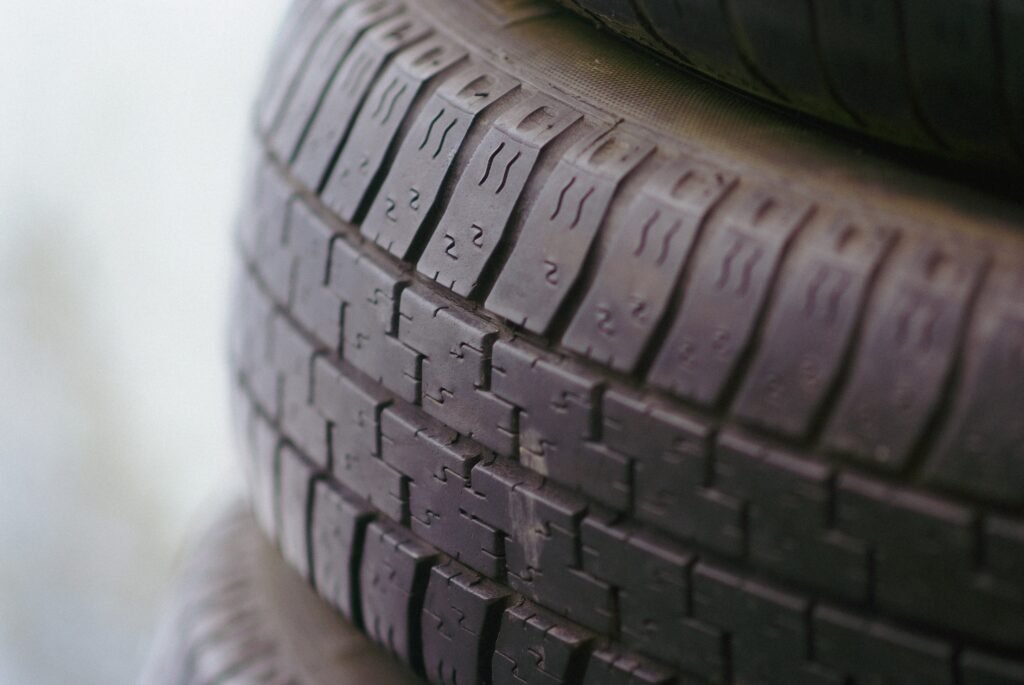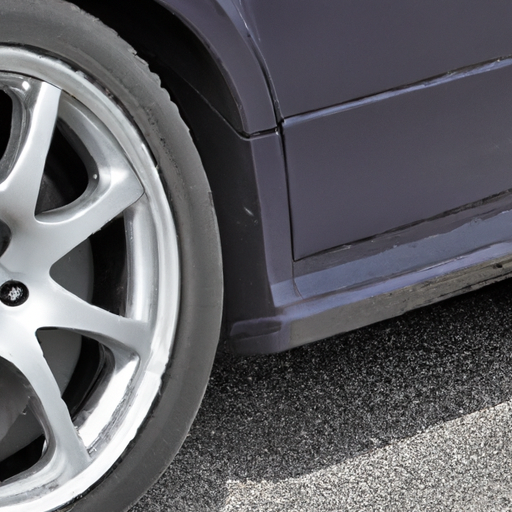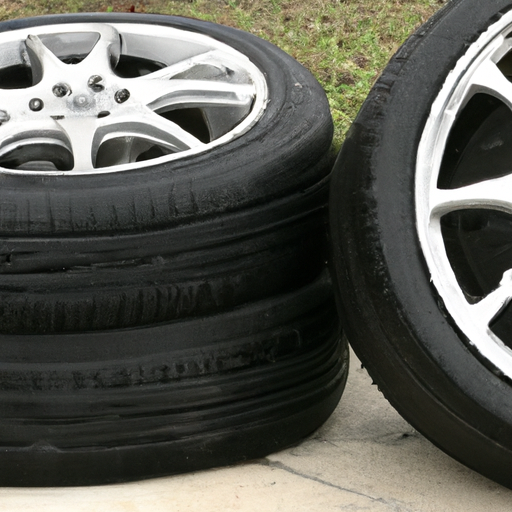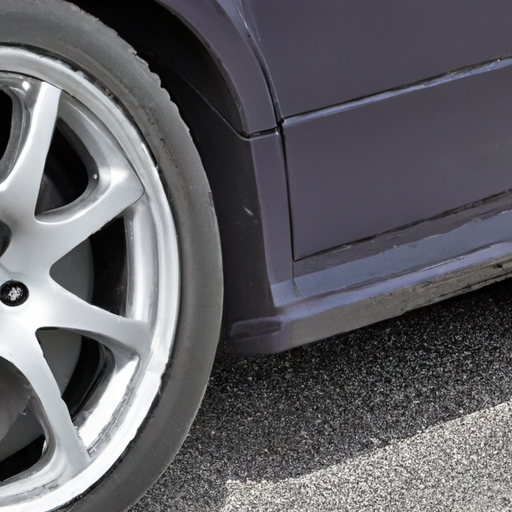In this article, we explore the impact of changing wheel sizes on your car’s performance. As a car owner, you may have wondered whether upgrading or downsizing your wheels could have any effect on how your vehicle performs. Well, the answer is yes! Altering your wheel sizes can affect various aspects of your car’s performance, including acceleration, handling, ride comfort, and fuel efficiency. So, let’s take a closer look at how changing wheel sizes can make a difference in how your car drives and what factors you should consider before making any modifications.

1. Tire Size Basics
1.1 Understanding Tire Size
Understanding tire size is crucial when it comes to selecting the right tires for your vehicle. The tire size is typically displayed on the side wall of your current tires and consists of a series of numbers and letters. These numbers represent the tire’s width, aspect ratio, and rim diameter. For example, if your tire size is P225/60R16, the “225” refers to the width of the tire in millimeters, the “60” represents the aspect ratio (the ratio of the tire’s height to its width), and the “16” indicates the diameter of the rim in inches.
1.2 Standard Tire Sizes
Standard tire sizes are those that are recommended by the vehicle manufacturer as the optimal size for your specific vehicle. These sizes are carefully chosen to ensure proper fitment, performance, and adherence to safety standards. When it comes to choosing standard tire sizes, it is important to consult your vehicle’s owner’s manual or contact the manufacturer directly for the recommended sizes.
1.3 Plus-Sizing and Minusing-Sizing
Plus-sizing and minusing-sizing are two techniques used to alter the tire size on a vehicle. Plus-sizing involves increasing the diameter of the tire and decreasing the aspect ratio, while minusing-sizing involves decreasing the diameter of the tire and increasing the aspect ratio. These modifications can have various effects on your car’s performance, and it is crucial to consider the implications before making any changes. It is recommended to consult with a professional tire dealer or automotive specialist before considering plus-sizing or minusing-sizing your tires.
2. Impact on Speedometer and Odometer
2.1 Effect on Speedometer Accuracy
Changing the size of your tires can have a significant impact on the accuracy of your vehicle’s speedometer. A larger tire diameter will cause your speedometer to read slower than your actual speed, while a smaller tire diameter will cause your speedometer to read faster. This discrepancy can lead to potential legal issues if your speedometer consistently displays a speed different from your actual velocity. It is important to recalibrate or adjust your speedometer accordingly when changing tire sizes to ensure accurate readings.
2.2 Odometer Readings and Mileage
Similarly, altering the tire size can also affect the accuracy of your vehicle’s odometer readings. A larger tire diameter will result in fewer revolutions per mile, causing your odometer to understate the distance traveled. Conversely, a smaller tire diameter will lead to more revolutions per mile, causing your odometer to overstate the distance traveled. This can impact both your maintenance schedule and the resale value of your vehicle, as the recorded mileage may not reflect the actual usage. Recalibrating your odometer or seeking professional assistance is essential when changing tire sizes.
2.3 Recalibrating Speedometer and Odometer
To maintain accurate speedometer readings and odometer readings, it is necessary to recalibrate both after changing the size of your tires. Many modern vehicles have electronic speedometer and odometer systems that can be recalibrated by a certified technician or through specialized software. This recalibration process involves adjusting the vehicle’s computer system to account for the changes in tire size, ensuring accurate readings. It is important to consult with a professional to ensure proper recalibration and avoid any legal or warranty issues.
3. Clearance and Fitment
3.1 Wheel Arch Clearance
Changing the tire size on your vehicle can have a significant impact on the clearance in the wheel arches. When selecting larger tires, especially those with a greater diameter, it is crucial to consider whether they will fit within the wheel arches without rubbing against the bodywork or other components. Insufficient clearance can lead to damage to your tires, suspension, and even your vehicle’s body. It is essential to consult with a professional tire dealer or automotive specialist to determine the maximum tire size that can be safely accommodated within your vehicle’s wheel arches.
3.2 Suspension and Brake Clearance
In addition to wheel arch clearance, changing tire sizes can also affect the clearance between your tires and the suspension components or brakes. Larger tires may come into contact with suspension elements such as struts, control arms, or brake calipers, resulting in potential damage or interference. Proper fitment is crucial to maintain the performance and safety of your vehicle’s suspension and braking systems. Consulting with a professional is recommended to ensure proper clearance and prevent any detrimental effects on your vehicle’s suspension or braking performance.
3.3 Fitment Issues
Fitment issues can arise when a tire size is not compatible with your vehicle’s specifications or design. These issues can encompass issues such as improper mounting, uneven tire wear, reduced handling capabilities, and compromised safety. It is important to adhere to the recommended tire sizes for your vehicle to minimize fitment issues and maximize the performance, safety, and longevity of your tires. Consulting with a professional tire dealer or automotive specialist can help you navigate the complexities of fitment and select the right tire size for your vehicle.
4. Handling and Ride Comfort
4.1 Impact on Steering Response
Changing tire sizes can have a noticeable impact on your vehicle’s steering response. Larger tires with a wider width may provide enhanced cornering stability and grip, resulting in improved steering response. On the other hand, smaller tires may result in reduced stability and less responsive steering. It is important to strike a balance between tire size and handling characteristics to ensure a comfortable and safe driving experience. Consulting with a professional tire dealer or automotive specialist can help you select the appropriate tire size for your desired handling preferences.
4.2 Influence on Cornering Stability
The tire size plays a significant role in the cornering stability of your vehicle. Wider tires provide a larger contact patch with the road, resulting in increased grip and improved cornering stability. However, excessively wide tires may also negatively impact ride comfort and fuel efficiency. It is crucial to consider the intended usage of your vehicle and strike a balance between cornering stability and other performance factors. Consulting with a tire professional can help you determine the optimal tire size to achieve the desired cornering stability without compromising other aspects of your vehicle’s performance.
4.3 Ride Quality and Comfort
Changing the size of your tires can affect the ride quality and comfort of your vehicle. Larger tires with a greater aspect ratio typically provide a smoother and more comfortable ride, as they absorb bumps and imperfections in the road surface more effectively. Conversely, lower aspect ratio tires may provide a stiffer ride with improved handling characteristics but may compromise comfort. It is important to consider your driving preferences and the condition of the roads you frequently travel on when selecting the appropriate tire size to strike a balance between ride quality and performance.

5. Acceleration and Fuel Efficiency
5.1 Effect on Acceleration
Altering the size of your tires can have a noticeable effect on your vehicle’s acceleration. Larger tires with a larger diameter may require more torque to rotate, resulting in slower acceleration. Conversely, smaller tires with a smaller diameter may require less torque, leading to quicker acceleration. It is essential to consider your desired performance and the trade-offs associated with tire size changes when making a decision. Consulting with a professional can help you understand the potential impact on acceleration and select an appropriate tire size that aligns with your preferences.
5.2 Impact on Fuel Efficiency
Changing the size of your tires can also impact your vehicle’s fuel efficiency. Larger tires generally have a higher rolling resistance due to increased weight and contact area, which can result in reduced fuel efficiency. Conversely, smaller tires may offer improved fuel efficiency due to reduced weight and rolling resistance. It is important to consider the balance between performance, fuel efficiency, and tire size when making a decision. Consulting with a tire professional can help you select the optimal tire size that provides the desired level of fuel efficiency without compromising other performance aspects.
5.3 Changes in Gear Ratio
Altering the size of your tires can result in changes to your vehicle’s gear ratio. A larger tire diameter effectively increases the gear ratio, making each gear feel taller. This can result in lower engine RPMs at a given speed, potentially improving fuel efficiency on the highway but sacrificing some low-end torque. Conversely, a smaller tire diameter effectively decreases the gear ratio, making each gear feel shorter and increasing engine RPMs at a given speed. This may provide improved acceleration but can negatively impact fuel efficiency. It is crucial to consider the desired trade-offs and consult with a professional to select the appropriate tire size for your desired gear ratios.
6. Braking Performance
6.1 Effect on Braking Distance
Changing the size of your tires can have implications for your vehicle’s braking performance. Larger tires may increase the overall contact area between the tires and the road surface, potentially improving braking performance by enhancing grip and reducing stopping distances. However, excessively wide tires may also result in reduced braking performance due to compromised weight distribution and increased rolling resistance. It is important to strike a balance between tire size and braking performance to ensure optimal safety on the road. Consulting with a professional can help you select the appropriate tire size to maintain or enhance your vehicle’s braking performance.
6.2 Brake Cooling and Ventilation
The size of your tires can also affect the cooling and ventilation of your vehicle’s brakes. Larger tires with wider widths may limit airflow to the brakes, potentially leading to increased heat buildup and reduced brake performance. It is important to consider this aspect, especially if you engage in aggressive driving or track use. Adequate brake cooling and ventilation are crucial for maintaining the effectiveness of your vehicle’s braking system. Consulting with a professional can help you select a tire size that ensures proper brake cooling and ventilation for your driving needs.
6.3 Braking Force Distribution
Altering the tire size can impact the distribution of braking forces within your vehicle’s braking system. Different tire sizes may affect the weight distribution of your vehicle, potentially leading to uneven braking force distribution. This can result in suboptimal braking performance, compromised handling, and increased tire wear. It is important to select a tire size that maintains proper weight distribution and evenly distributes braking forces across all wheels. Consulting with a professional can help you determine the appropriate tire size to ensure optimal braking force distribution and maximize your vehicle’s safety.

7. Load Carrying Capacity
7.1 Effect on Maximum Load
Changing the size of your tires can impact the maximum load carrying capacity of your vehicle. Larger tires with a higher load rating may be able to support greater weights, allowing for increased cargo or passenger loads. Conversely, smaller tires with a lower load rating may limit the maximum weight that can be safely carried by your vehicle. It is crucial to adhere to the load rating specifications provided by the vehicle manufacturer and select the appropriate tire size to ensure safe load carrying capacity. Consulting with a professional can help you understand the implications of tire size changes on your vehicle’s load capacity.
7.2 Impact on Towing Capacity
The size of your tires can also affect your vehicle’s towing capacity. Larger tires with a greater load rating may provide increased towing capacity, allowing you to tow heavier trailers or loads. Smaller tires with a lower load rating may limit your vehicle’s towing capabilities. It is important to consult your vehicle’s owner’s manual or contact the manufacturer to understand the recommended tire sizes for towing purposes. Properly selecting the tire size that aligns with your towing needs is crucial to ensure safe and efficient towing operations.
7.3 Overloading and Safety
Changing the tire size without considering the implications on load carrying capacity can result in overloading your vehicle. Overloading can have severe safety implications, leading to reduced stability, compromised braking performance, increased tire wear, and potential tire failure. It is essential to adhere to the load carrying capacity specifications provided by the vehicle manufacturer and select the appropriate tire size accordingly. Consulting with a professional can help you understand the safety considerations associated with tire size changes and ensure optimal load carrying capacity without jeopardizing your safety.
8. Tire Cost and Availability
8.1 Price Differences
The size of your tires can have an impact on the cost of replacement tires. Larger tires generally tend to be more expensive than smaller tires due to factors such as increased material usage and specialized manufacturing processes. It is important to factor in the potential cost differences when considering changing tire sizes. Additionally, availability may also vary based on tire size, with certain sizes being more readily available than others. Consulting with a tire dealer or automotive specialist can help you explore the cost and availability factors associated with different tire sizes and make an informed decision.
8.2 Availability and Variety
Changing the tire size on your vehicle may impact the availability and variety of tire options. Popular or standard tire sizes tend to have a wider selection of tire brands and models available, providing you with more choices when it comes to performance, comfort, or specific requirements. Less common or non-standard tire sizes may limit your options and potentially result in higher costs or reduced availability. It is important to consider the implications on tire availability and variety when deciding on changing tire sizes. Consulting with a tire dealer or automotive specialist can help you understand the available options and select the tire size that meets your specific needs and preferences.

9. Considerations for Off-Roading
9.1 Influence on Off-Road Capability
The size of your tires can significantly impact the off-road capability of your vehicle. Larger tires with increased width and aspect ratio can provide enhanced traction, better ground clearance, and improved ability to traverse rough terrains. However, excessively large tires may result in reduced maneuverability, increased strain on the suspension, and potential clearance issues. It is important to strike a balance between tire size and off-road capabilities, taking into account factors such as suspension travel, fender clearance, and the intended off-road usage. Consulting with a professional off-road specialist can help you determine the optimal tire size for your off-road adventures.
9.2 Clearance and Traction
When off-roading, tire clearance and traction are paramount. Larger tires allow for increased ground clearance, reducing the likelihood of getting stuck on obstacles or damaging the undercarriage. Additionally, wider tires with aggressive tread patterns offer enhanced traction on uneven or loose surfaces, improving your vehicle’s ability to maintain control and overcome challenging terrain. However, it is important to consider the potential trade-offs, such as reduced steering response or increased strain on drivetrain components. Striking the right balance between tire size, clearance, and traction is crucial for a successful and safe off-road experience.
9.3 Effects on Suspension and Shocks
Altering the tire size can affect the suspension and shocks of your vehicle, especially when it comes to off-roading. Larger tires may put additional strain on your vehicle’s suspension components and shocks, potentially leading to increased wear and reduced lifespan. The increased weight and impact forces associated with off-roading can further exacerbate the strain on the suspension and shocks. It is crucial to consider the compatibility of your suspension system with larger tire sizes and potentially invest in upgraded suspension components or shocks to handle the increased demands. Consulting with a professional off-road specialist can help you understand the implications on suspension and shocks and ensure optimal performance and durability for your off-road pursuits.
10. Manufacturers and Warranty
10.1 Recommendations from Manufacturers
Vehicle manufacturers generally provide recommendations regarding tire sizes for their vehicles. These recommendations are based on extensive testing and engineering to ensure optimal performance, safety, and compliance with regulatory standards. It is important to adhere to the manufacturer’s recommendations when it comes to tire size selection to ensure the performance, reliability, and warranty coverage of your vehicle. Deviating from the recommended tire sizes may void your warranty or result in compromised performance. Consulting with your vehicle’s manufacturer or authorized dealers can provide you with valuable insights and guidance on tire size selection.
10.2 Impact on Warranty Coverage
Changing the tire size on your vehicle can have implications for your warranty coverage. Manufacturers typically design their vehicles to specific specifications and performance standards, including tire size requirements. Deviating from these requirements may result in voiding your vehicle’s warranty, as it can be seen as a modification that compromises the vehicle’s performance, safety, or reliability. It is crucial to consult your vehicle’s owner’s manual or contact the manufacturer directly to understand the warranty coverage associated with tire size changes. Seeking professional advice and adhering to the manufacturer’s recommendations can help you avoid any potential warranty issues and ensure optimal coverage for your vehicle.
In conclusion, changing the tire size on your vehicle can have various effects on its performance, safety, and overall driving experience. It is essential to consider the implications on speedometer accuracy, odometer readings, clearance and fitment, handling and ride comfort, acceleration and fuel efficiency, braking performance, load carrying capacity, tire cost and availability, considerations for off-roading, as well as manufacturer recommendations and warranty coverage. Consulting with a professional tire dealer, automotive specialist, or off-road expert is recommended to ensure you make an informed decision and select the appropriate tire size that meets your specific needs and preferences while safeguarding the performance and safety of your vehicle.


